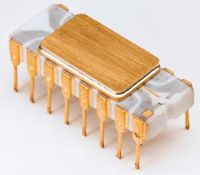(initial page) |
|||
| Line 1: | Line 1: | ||
{{title|First}} | {{title|First}} | ||
'''First''' in computer engineering is almost always a controversial topic. Historically, many products were often designed around the same time by different organizations and were introduced around the same time. Below is a list of "firsts". | '''First''' in computer engineering is almost always a controversial topic. Historically, many products were often designed around the same time by different organizations and were introduced around the same time. Below is a list of "firsts". | ||
| + | |||
| + | == First Digital Computer == | ||
| + | The argument over the first general purpose digital computer was so controversial, it actually made it all the way to a U.S. federal court. Candidates for the first digital computer: | ||
| + | |||
| + | * [[Model K]] | ||
| + | * [[Z2]] | ||
| + | * [[Atanasoff–Berry computer]] (ABC) | ||
| + | * [[ENIAC]] | ||
| + | |||
| + | Atanasoff's computer, [[Atanasoff–Berry computer]] (ABC) was conceived in 1939 at the Iowa State University where he worked along with the help of a graduate student, Clifford Berry. In 1947, [[ENIAC]] applied for [https://www.google.com/patents/US3120606 US Patent 3120606] for their computer which was granted in 1964. In the landmark case ''[[Honeywell, Inc. v. Sperry Rand Corp.]]'', in a controversial ruling, the court credited [[John Vincent Atanasoff]] with the invention of the electronic [[digital computer]]. The same case ended up invalidating the ENIAC patent, leaving the invention of the electronic digital computer in the public domain. | ||
| + | |||
| + | Just two years earlier, in 1937, [[George Stibitz]] conceived his own relay-based digital computer, the ''[[Model K]]'' at [[Bell Labs]]. By the end of the year Bell Labs authorized a full research project which resulted in the ''[[Model I]]'' (formerly the ''Complex Number Computer'') in late 1939. | ||
| + | |||
| + | Around the very same time the ABC was being developed in the United States, [[Konrad Zuse]], a German civil engineer, conceived the ''[[Z2]]''. The Z2 was a [[relay computer|relay-based digital computer]] consisting of around 2,000 relays. Allied bombing during World War II destroyed much of the original plans. | ||
== First Microprocessor == | == First Microprocessor == | ||
Revision as of 22:37, 10 July 2017
First in computer engineering is almost always a controversial topic. Historically, many products were often designed around the same time by different organizations and were introduced around the same time. Below is a list of "firsts".
First Digital Computer
The argument over the first general purpose digital computer was so controversial, it actually made it all the way to a U.S. federal court. Candidates for the first digital computer:
Atanasoff's computer, Atanasoff–Berry computer (ABC) was conceived in 1939 at the Iowa State University where he worked along with the help of a graduate student, Clifford Berry. In 1947, ENIAC applied for US Patent 3120606 for their computer which was granted in 1964. In the landmark case Honeywell, Inc. v. Sperry Rand Corp., in a controversial ruling, the court credited John Vincent Atanasoff with the invention of the electronic digital computer. The same case ended up invalidating the ENIAC patent, leaving the invention of the electronic digital computer in the public domain.
Just two years earlier, in 1937, George Stibitz conceived his own relay-based digital computer, the Model K at Bell Labs. By the end of the year Bell Labs authorized a full research project which resulted in the Model I (formerly the Complex Number Computer) in late 1939.
Around the very same time the ABC was being developed in the United States, Konrad Zuse, a German civil engineer, conceived the Z2. The Z2 was a relay-based digital computer consisting of around 2,000 relays. Allied bombing during World War II destroyed much of the original plans.
First Microprocessor

The first microprocessor is a subject of heated debate. Below is a number of popular candidates:
With development starting in 1968 and completing around June of 1970, the MP944 chipset is one of the earliest examples of a complete VLSI micro-computer system chipset. The MP944 is 20-bit microprocessor designed by Garrett AiResearch specifically for the Grumman F-14 Tomcat's Central Air Data Computer. The project remained classified for over 40 years. In early 1970 at least three additional microprocessors were already under development. Intel started working on the 4004 in April 1970. According to a number of source, the Fairchild's PPS-25 was initially introduced in the second quarter 1971[1]. This would place it 2 quarters ahead of Intel's 4004 which was introduced in November 1971. TI announced, albeit never actually commercialized, the TMX1795 which is effectively TI's own implementation of Intel's 8008 - both were based on the same specifications drafted by the Computer Terminal Corporation.
References
- ↑ Ogdin, Jerry. "Microprocessor scorecard." Euromicro Newsletter 1.2 (1975): 43-77.